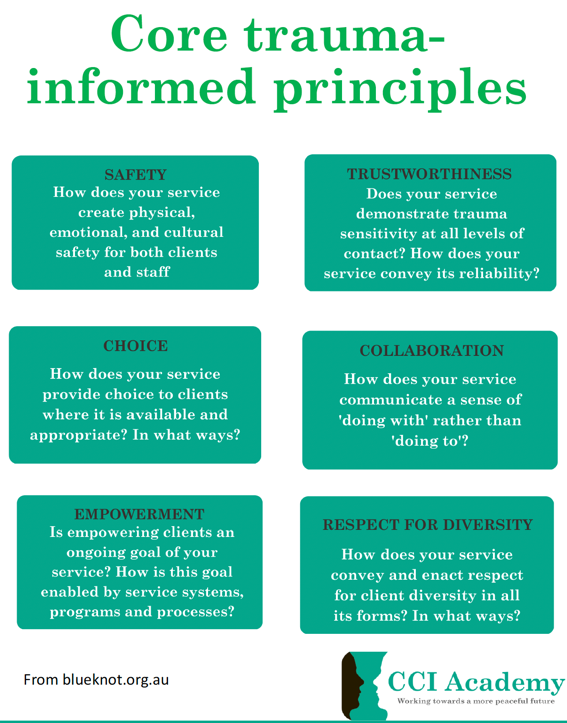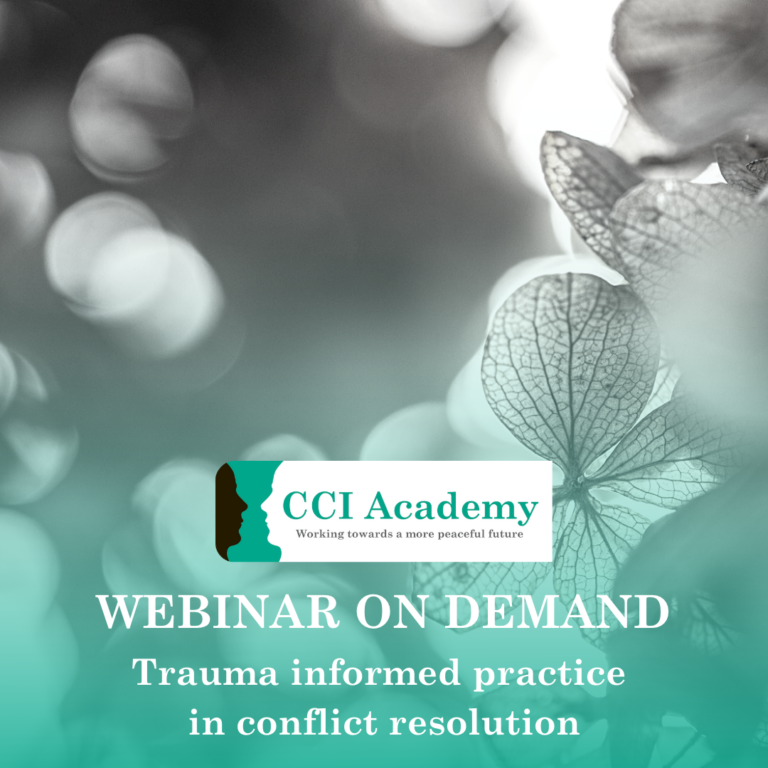What is trauma informed practice?
There is a lot of talk at the moment about trauma, and the need for a broad range of practitioners to ensure that their practice is “trauma-informed”. This includes anyone who works with people who may have experienced trauma, not just those who provide therapeutic services to survivors of trauma. Having a trauma-informed practice is not about providing treatment and doesn’t require clinical knowledge.
“Trauma-informed care is a strengths-based service delivery approach “that is grounded in an understanding of and responsiveness to the impact of trauma, that emphasizes physical, psychological, and emotional safety for both providers and survivors, and that creates opportunities for survivors to rebuild a sense of control and empowerment” (Hopper, Bassuk, & Olivet, 2010, p. 82).
People who provide conflict management and resolution services are likely to have clients who have experienced trauma. This isn’t limited to practitioners working with families with a history of violence. Anyone who comes for support with conflict may have experienced trauma in their lives.
What is trauma?
Trauma may be physical, developmental, emotional, relational and/or spiritual. Trauma results when a person experiences an emotional response to a distressing experience that overwhelms one’s ability to protect oneself and stay safe. Traumatic events undermine a person’s sense of safety in the world and create the feeling that catastrophe could strike at any time.
It can be easy to fall into the trap of questioning whether or not a person has really experienced trauma. This is a slippery slope. Check out this interesting article about how to avoid policing the term ‘trauma’.
Results of trauma
There are many different effects that trauma may have on an individual, including social impacts, such as conflicts with others, inability to collaborate, rigidity, impatience, poor communication and blaming others. Those of us who work with people in conflict see these kinds of behaviours fairly frequently, but they are not always caused by trauma. The point is, however, that we often don’t know whether they are or not, and there is a risk that if they are trauma-induced we may respond in a way that is not helpful, or worse, that is harmful.
(NOTE: It is also important to point out that some people can develop resilience, a sense of self-efficacy, and post-traumatic growth. Trauma does not always mean that a person’s life will be forever full of these kinds of symptoms).
Core trauma-informed principles
There are six main principles that practitioners should keep in mind when reviewing and ensuring a trauma-informed practice. These are safety, trustworthiness, choice, collaboration, empowerment and respect for diversity.

How might we apply these principles in a conflict resolution practice?
Here are three suggestions:
- Evaluate all the components of your practice (and the various services you provide) in light of a basic understanding of trauma. In other words, how might someone who has a history of trauma experience their interactions with your service at every step of the way?
- Design / revise your processes and systems to accommodate the vulnerabilities of trauma survivors and avoid\ inadvertent re-traumatization.
- Ensure that you have strong referral pathways and relationships with other services that support clients who have experienced trauma.

- Do you have an appropriate screening process that may help you identify clients who have experienced trauma?
- Could you recognise some of the symptoms that someone who has experienced trauma may display in a conflict resolution process?
- Do you understand how to interact with people who have experienced trauma so as not to increase trauma? How might you need to adapt your normal interventions if you are working with a client who you know, or suspect, has experienced trauma?
- How much opportunity do you give your clients to have control over the processes you offer? How transparent are you about what, exactly, will happen at each stage of your client/practitioner relationship?
- How much opportunity do you give your clients to set interpersonal boundaries and to refuse to answer or participate if they no longer feel comfortable?
- Are you confident in working with a client who has experienced trauma to develop an agreement about what to do if the client is triggered during any service you are providing?
- Do you give clients choices about where services are provided, including things like where they wait before or during service provision, and whether / how you contact them (or they contact you)?
- If you, yourself, have experienced trauma, how might that impact on your work as a practitioner (particularly with conflicts that could potentially trigger you, or with clients who have also experienced trauma in their lives)?
Where to learn more
This is only a very broad overview of some of the things that practitioners should consider in reviewing and developing their practice to be trauma informed.
There are many organisations who provide resources and training to support practitioners in this process. One that I have found to be very good in Australia is blueknot.org.au.

You might also like to watch our Webinar on Demand: Trauma informed practice in conflict resolution. Find out more and register here: https://conflictmanagementacademy.com/webinar-on-demand-trauma-informed-practice-in-conflict-resolution/

